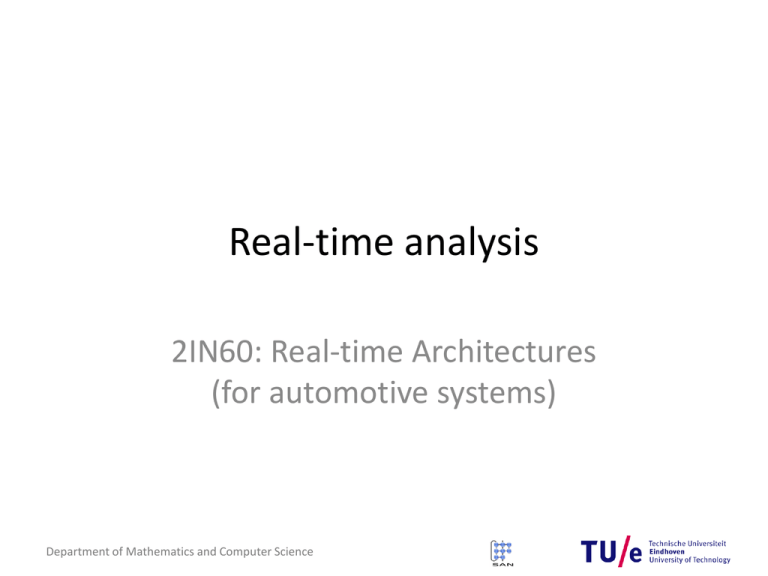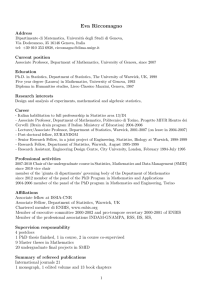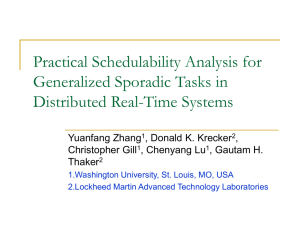Slides
advertisement

Real-time analysis
2IN60: Real-time Architectures
(for automotive systems)
Department of Mathematics and Computer Science
Goals for this slide set
• Describe the real-time scheduling model with all
the relevant parameters
• Explain the difference between necessary,
sufficient and exact schedulability conditions
• Explain the notion of a critical instant
• Describe the utilization and worst-case response
time analysis (including all relevant equations)
• Apply the utilization and worst-case response
time analysis to a real-time system
• Describe how context switches and interrupt
handling can be incorporated in the analysis
Department of Mathematics and Computer Science
2
Outline
• Real-time scheduling model
• Worst-case schedulability analysis
–
–
–
–
Schedulability conditions
Critical instance
Utilization analysis
Response time analysis
• Practical factors
–
–
–
–
Activation jitter
Context switches
External interrupts
Timer interrupt
Department of Mathematics and Computer Science
3
Modeling software systems
• When investigating the root causes for traffic
jams in a city, it is infeasible to consider the
interactions between molecules comprising
the car or the driver’s brain
• A model is an abstraction of the key elements
which are relevant for achieving a given goal
– Example: traffic in a city can be modeled by means
of a queue network representing the streets, and
Markov chains describing the arrival of cars
Department of Mathematics and Computer Science
4
A basic scheduling model
• Event:
– Indicates a state change requiring a timely response, i.e. neither
too early nor too late
– Internal (e.g. one task triggering another task)
– External (e.g. interrupt from a sensor)
– Timed (e.g. activation of a periodic task)
• Task: actions in response of event
– Task instance is termed a job
– A periodic task will generate infinitely many jobs with given
period and offset
• Processor: executes a single task at a time
• Schedule: assignment of tasks to processor during runtime
Department of Mathematics and Computer Science
6
Task attributes
job i,k
Ti
ai,k
si,k
• A task i has
–
–
–
–
–
+
Ci
fi,k
ai,k+1
name (the ith task)
computation (or execution) time
relative deadline
period (sometimes)
phasing (activation of job 0)
i
Ci
Di
Ti , Tmini ,Tmaxi
φi
activation (or release) time
absolute deadline
start (or begin) time
finalization (or end) time
ai,k
di,k
si,k
fi,k
• A job i,k has
–
–
–
–
di,k
time
Department of Mathematics and Computer Science
7
Task deadlines
• Deadline: the latest time before which a job must
complete
– Relative: Di (relative to the job activation time ai,k)
– Absolute: di,k = ai,k + Di
Di
ai,k
release
time
di,k
deadline
• The consequences of a job missing its deadline
(i.e. providing a response after the deadline)
determine the type of deadline
Department of Mathematics and Computer Science
8
Deadline types
• Soft
– A response is still valuable after the deadline, but value decreases
steadily after that
• Example: interaction with human users. People get impatient.
• Firm
– A response has no value after the deadline
• Example: a video frame that cannot be shown in time can be skipped
• Hard
– Damage is done if a response does not come in time.
• Example: signal to inflate the airbag
Department of Mathematics and Computer Science
9
Derived attributes
• ai,k = i + kTi
• Ui = Ci / Ti
• U = ∑ Ui
• Ri,k = fi,k – ai,k
activation time of job i,k
of a periodic task i
utilization of task i
total utilization of task set
response time of job i,k
k
Department of Mathematics and Computer Science
10
Schedule
• Definition:
– Set of n tasks = {1, …, n}
– Schedule is a function mapping the processor at any time to one
task from the task set
• : R → ∪{⊥}, where (t) = ⊥ means idle
• Fixed priority preemptive scheduling (FPPS)
– De-facto standard in the industry
• From simple control applications …
• to large defense and aero-space applications
– Supported by commercial RTOS (e.g. μC/OS-II)
– Definition:
• Each task is assigned a unique fixed priority
• At any time the processor is assigned to the highest priority ready task
Department of Mathematics and Computer Science
11
Schedule: example
• FPPS schedule of three independent tasks 1, 2, 3,
where 1 has highest the priority and 3 the lowest priority
3
2
1
⊥
Department of Mathematics and Computer Science
12
Outline
• Real-time scheduling model
• Worst-case schedulability analysis
–
–
–
–
Schedulability conditions
Critical instance
Utilization analysis
Response time analysis
• Practical factors
–
–
–
–
Activation jitter
Context switches
External interrupts
Timer interrupt
Department of Mathematics and Computer Science
13
Schedulability conditions
• Requirement:
– all jobs of all tasks of must meet their deadline
constraints, i.e.
"i,k : Ri,k £ Di
• Derived notions for task i
– Worst-case response time WRi
def
WRi = sup Ri,k
k
– Critical instant: a (hypothetical) instant that leads to
WRi
Department of Mathematics and Computer Science
14
Schedulability conditions
• Types of conditions:
– Necessary condition
Condition Ü ("i,k : Rik £ Di )
– Sufficient condition
Condition Þ ("i,k : Rik £ Di )
– Exact condition
Condition Û ("i,k : Rik £ Di )
• Examples:
– Necessary condition: Ci Di
– Sufficient condition: utilization analysis (see later)
– Exact condition: worst-case response time analysis (see later)
Department of Mathematics and Computer Science
15
Terminology
• Preemption
– Interference from higher priority tasks and ISRs
• Blocking
– Interference from lower priority tasks
• Interruption
– Arrival of an interrupt and consequently its ISR
– Leads to a preemption of a task (since ISRs have
higher priority than tasks)
Department of Mathematics and Computer Science
16
Overview of basic assumptions
• Events: implicit
• Set of n tasks 1, …, n:
–
–
–
–
–
Released periodically
Arbitrary phasing
No self-suspension
A job does not start before previous job completed (fi,k-1 si,k)
Hard deadlines and Di Ti
• Single processor
• Scheduling:
– FPPS with unique priorities
– Instantaneous pre-emption and non-idling
– Overhead of context switching and task scheduling is ignored
• Notational convenience:
– Tasks are given in order of decreasing priority
• i.e. 1 has highest priority and n has lowest priority
Department of Mathematics and Computer Science
17
Utilization analysis
(independent tasks)
• Assumptions (additional):
– Rate monotonic priority assignment
• Smaller period means higher priority
– Deadlines equal to periods: i.e. Di = Ti
– Independent tasks
• i.e. no resource sharing and no precedence constraints
• Necessary condition: U 1
• Sufficient condition: U n (21/n – 1), where n = ||
–
–
–
–
RHS is strictly decreasing in n
Converges to ln(2) (≈ 0.69) for n
LL(n) = n (21/n – 1), called the Liu and Layland bound for n tasks
See [Liu and Layland 73]
Department of Mathematics and Computer Science
18
Utilization analysis
schedulable
0
not schedulable
?
n(21/n-1)
Department of Mathematics and Computer Science
1
19
Utilization
Utilization analysis: example
• Task set consisting of 3 tasks:
Task
T
C
U
1
10
3
0.30
2
19
11
0.58
3
56
5
0.09
• Notes:
– RM priority assignment and Di = Ti (RMS)
– Necessary condition:
• U1 + U2 + U3 = 0.97 1, hence could be schedulable
– Sufficient condition:
• U1 + U2 + U3 = 0.97 > LL(3) 0.78, hence could be not schedulable
– Hence, another test required
Department of Mathematics and Computer Science
20
Utilization analysis
(dependent tasks)
• Assumptions (additional):
– Rate monotonic priority assignment
– Deadlines equal to periods: i.e. Di = Ti
– Dependent tasks: tasks may share mutually-exclusive
resources
• Necessary condition:
• Sufficient condition:
UG £ 1
Bi
U + max ( ) £ n(21/n -1)
Ti
G
where n = ||
• See [Sha et al 90]
Department of Mathematics and Computer Science
n-1
i=1
21
Critical Instant
• Critical instant for task i: scenario when I assumes its WRi.
1
Task 2 is preempted by a single
activation of the higher priority task 1.
2
C2 + C1
1
The interference increases when the
activation of task 1 is advanced.
2
C2 + 2C1
0
10
20 time
Department of Mathematics and Computer Science
22
Critical instant: independent tasks
• A critical instant occurs upon a simultaneous release of a
task with all its higher priority tasks
– Note: “A” rather than “the”, because there may be more
instants for which i “assumes” its WRi
Department of Mathematics and Computer Science
23
Critical instant: dependent tasks
• Blocking time Bi:
– Longest time i can be blocked by lower priority
tasks
– Depends on the resource access protocol
• Disabling interrupts or scheduler:
– longest critical section of a lower priority task
• Mutex with Priority Calling Protocol:
– (complicated, see literature)
• Mutex with SRP:
– longest critical section of a lower priority task with a resource
ceiling higher or equal to the priority of i
Department of Mathematics and Computer Science
24
Critical instant: dependent tasks
• A critical instant occurs upon a simultaneous release of a
task with all its higher priority tasks, and all lower priority
tasks contributing to the worst-case blocking time have
executed an ϵ time of their critical section
Department of Mathematics and Computer Science
25
Worst-case response time analysis
(independent tasks)
• Additional assumptions:
– Independent tasks
• i.e. no resource sharing and no precedence constraints
• Worst-case response time of a task:
– Longest possible response time among all task jobs:
WRi = supk (fi,k – ai,k)
• Methods for analysing a critical instance:
– Timeline
– Calculation
Department of Mathematics and Computer Science
26
WCRT methods: timeline
1
T
C
2
1 10
3
2 19
1
1
3
3 56
5
0
10
20
30
WR1 = 3
WR2 = 17
WR3 = 56
Department of Mathematics and Computer Science
27
40
50
60 time
WCRT methods: calculation
– Recursive equation for task i:
éxù
x = Ci + å ê úC j
j<i êT j ú
– WRi is the smallest positive solution for x
– Assume a task j with a higher priority than i;
• x/Tj denotes the maximum number of preemptions
of task i in an interval [0, x) by task j;
• x/TjCj denotes the maximal preemption time
of task i in an interval [0, x) by task j.
– Intuition:
• LHS: amount of time available (or provided) in [0, x);
• RHS: max. amount of time requested in [0, x) by i and j < i : j.
Department of Mathematics and Computer Science
28
WCRT methods: calculation
• Iterative procedure:
WRi(0) = Ci + åC j
j<i
é WR(k ) ù
WRi(k+1) = Ci + å ê i úC j
ú
j<i ê Tj
– Stop when either:
• WRi(k+1) = WRi(k) (which is the value of WRi)
• the deadline Di is exceeded (hence, not schedulable).
– All intermediate values are at most equal to WRi;
– The procedure terminates when j < i: Uj < 1.
– See [Harter 84], [Joseph et al 86] or [Audsley et al 91].
Department of Mathematics and Computer Science
29
WCRT methods: calculation
• Example for task 3:
–
–
–
–
–
–
–
–
–
T
C
1 10
3
2 19
1
1
C3 + j < 3: Cj = 5 + 3 + 11 = 19
3 56
C3 + j < 3: WR3 (0)/TjCj =
5 + 19/103 + 19/1911 = 5 + 23 + 111 = 22
WR3(2) = 5 + 22/103 + 22/1911 = 5 + 33 + 211 = 36
WR3(3) = 5 + 36/103 + 36/1911 = 5 + 43 + 211 = 39
WR3(4) = 5 + 39/103 + 39/1911 = 5 + 43 + 311 = 50
WR3(5) = 5 + 50/103 + 50/1911 = 5 + 53 + 311 = 53
WR3(6) = 5 + 53/103 + 53/1911 = 5 + 63 + 311 = 56
WR3(7) = 5 + 56/103 + 56/1911 = 5 + 63 + 311 = 56
Because WR3 (6) = WR3 (7) = 56 ≤ D3 = T3, WR3= 56.
WR3(0) =
WR3(1) =
Department of Mathematics and Computer Science
30
5
WCRT methods: calculation
1
1
2
2
3
1
4
5
2
6
3
3
19 22
0
10
20
36 39
30
40
50 53 56
50
(0) = 5 + 3 + 11 = 19
WR3(6)
WR3 = WR3(7) = 5 + 6·3 + 3·11 = 56
WR3(1) = 5 + 23 + 111 = 22
WR3(2) = 5 + 33 + 211 = 36
Department of Mathematics and Computer Science
31
60 time
T
C
1 10
3
2 19
1
1
3 56
5
Worst-case response time analysis
(dependent tasks)
• Additional assumptions
– Dependent tasks: tasks may share mutuallyexclusive resources
• Worst-case response time analysis:
– Recursive equation for task i:
éxù
x = Bi + Ci + å ê úC j
j<i êT j ú
WRi is the smallest positive solution for x
Department of Mathematics and Computer Science
32
Be aware!
The presented analysis has the explicitly stated
assumptions as preconditions!
Department of Mathematics and Computer Science
33
Outline
• Real-time scheduling model
• Worst-case schedulability analysis
–
–
–
–
Schedulability conditions
Critical instance
Utilization analysis
Response time analysis
• Practical factors
–
–
–
–
Activation jitter
Context switches
External interrupts
Timer interrupt
Department of Mathematics and Computer Science
34
Activation jitter
• Extension of the recursive equation
é x + AJ ù
j
x = Ci + å ê
úC j
Tj ú
j<i ê
– AJj is the activation jitter of task j
Department of Mathematics and Computer Science
37
Context switches
• Question: how many jobs of another task can a job pre-empt,
assuming independent tasks?
• Answer: at most 1!
context switch
i
j
• Let CS denote the context-switch time of the system, i.e.
– max time the system spends on a context switch;
– optionally including time of the scheduler to service the event
interrupt that triggered the context switch
Department of Mathematics and Computer Science
38
Context switches
• Extending the analysis:
– Replace Cj by Cj + 2CS;
– Replace Ci by Ci + 2CS;
• Questions:
– Can these extensions be applied for the necessary
condition, sufficient condition, and response-time
analysis?
– Can you ignore the context switch out-of a task in
the response time analysis of that task, i.e. use
Ci + CS rather than Ci + 2CS?
Department of Mathematics and Computer Science
39
External interrupts
• Interrupt service routines will pre-empt a running task ;
– even when the sporadic task handling the interrupt has a lower
priority than .
• Let
– Tk: the minimum inter-arrival time of the interrupt triggering
interrupt service routine k;
– x: the set of external interrupts;
– Ck: the cost of handling that interrupt.
• Extension of the recursive equation
Department of Mathematics and Computer Science
40
Clock interrupt
• Similar to external interrupts
• Extension of the recursive equation
Department of Mathematics and Computer Science
41
Summary of mutual exclusion primitives
Primitive
Pros
Cons
Disable
interrupts
•
•
•
•
Avoid deadlock
Simple implementation
Simple analysis
Prevent interference from
interrupts
• Higher priority tasks not sharing
resources are penalized
• Interrupts can be missed
Disable
scheduler
•
•
•
•
Avoid deadlock
Simple implementation
Simple analysis
Allow interrupts
• Higher priority tasks not sharing
resources are penalized
• Cannot guard resources shared with ISRs
Mutex
• Allow interrupts
• Higher priority tasks not sharing
resources are not penalized
• Avoid “unbounded” priority
inversion
Semaphore • Allow interrupts
• Higher priority tasks not sharing
resources are not penalized
Department of Mathematics and Computer Science
42
• Can lead to deadlock (depends on
implementation)
• Cannot guard resources shared with ISRs
• Suspension not allowed in ISRs
•
•
•
•
Can lead to deadlock
Cannot guard resources shared with ISRs
Suspension not allowed in ISRs
“Unbounded” priority inversion
References
• Recommended reading:
– [Burns] Ch. 11.2–6, 11.8
• Optional reading:
– [Audsley et al 91] N.C. Audsley and A. Burns and M.F. Richardson and A.J.
Wellings, Hard Real-Time Scheduling: The Deadline Monotonic Approach, In:
Proc. 8th IEEE Workshop on Real-Time Operating Systems and Software
(RTOSS), pp. 133-137, May 1991.
– [Harter 84] P. Harter, Response times in level-structured systems, Department
of Computer Science, University of Colorado, USA, Tech. Rep. CU-CS-269-84,
1984.
– [Joseph et al 86] M. Joseph and P. Pandya, Finding Response Times in a RealTime System, The Computer Journal, 29(5): 390-395, 1986.
– [Liu and Layland 73] C.L. Liu and J.W. Layland, Scheduling Algorithms for
Multiprogramming in a Real-Time Environment, Journal of the ACM, 20(1): 4661, January 1973.
– [Sha et al 90] L. Sha, R. Rajkumar, J.P. Lehoczky, Priority inheritance protocols:
An approach to real-time synchronization, IEEE Transactions on Computers,
39(9), September 1990
Department of Mathematics and Computer Science
43


